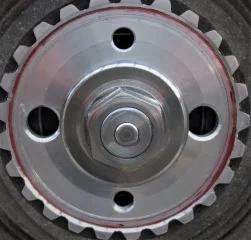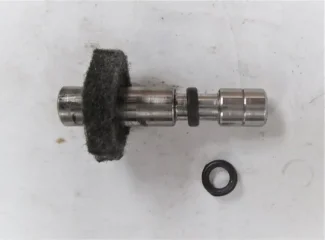- Joined
- Sep 15, 2020
- Messages
- 396
I have one of these.... http://atlanticgreen.com/ddacrs.htm
I put the regular nut on with washer and the clutch housing (the first part to go on) cinches up well against the gearbox main shaft. When I put this extended nut on to the point of the housing being snug, there's no threads left to put the seal retainer in.
First pic shows the nut turned all the way in - there's a thick lock washer underneath it, and it's got no inner threads to spare in order to insert the O-ring seal holder.
Second pic shows the inner seal holder, I think it must need to slip over the end of the shaft, but it does not. It may get close if it could set fully on the end of the shaft, but not close enough to snug up the clutch housing. I am not sure what I'm missing, some spacer? On the shaft itself under the clutch housing I have a thrust washer. There is little in the way of diagrams to help me here that I can find.
Shows the nut screwed in until the clutch housing is snug against the main shaft. No threads, and if I put the seal housing in and tightened it, damage would ensue one way or another (either it would not slip over the end of the shaft and it may deform, or it would slip over and crunch the O-Ring and possibly split the end of the seal housing).
Ay Carumba!

Should this slip over? I'd have to modify the outside surface of the shaft (sand it with emery) to make it do so.

I put the regular nut on with washer and the clutch housing (the first part to go on) cinches up well against the gearbox main shaft. When I put this extended nut on to the point of the housing being snug, there's no threads left to put the seal retainer in.
First pic shows the nut turned all the way in - there's a thick lock washer underneath it, and it's got no inner threads to spare in order to insert the O-ring seal holder.
Second pic shows the inner seal holder, I think it must need to slip over the end of the shaft, but it does not. It may get close if it could set fully on the end of the shaft, but not close enough to snug up the clutch housing. I am not sure what I'm missing, some spacer? On the shaft itself under the clutch housing I have a thrust washer. There is little in the way of diagrams to help me here that I can find.
Shows the nut screwed in until the clutch housing is snug against the main shaft. No threads, and if I put the seal housing in and tightened it, damage would ensue one way or another (either it would not slip over the end of the shaft and it may deform, or it would slip over and crunch the O-Ring and possibly split the end of the seal housing).
Ay Carumba!
Should this slip over? I'd have to modify the outside surface of the shaft (sand it with emery) to make it do so.



